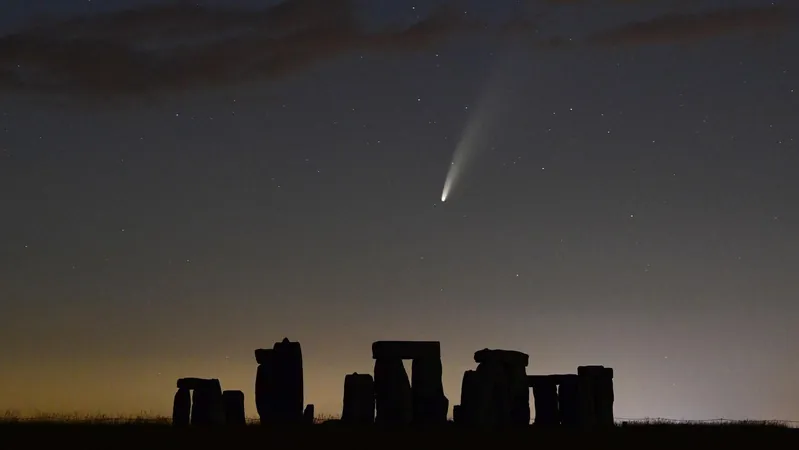
How to Capture Stunning Photos of Comet A3 With Your Smartphone or Camera
2024-09-27
Author: Michael
How to Capture Stunning Photos of Comet A3 With Your Smartphone or Camera
Excitement is building as Comet A3 is on track to become the brightest comet of 2024, especially around mid-October. For those eager to catch a glimpse, the first set of images from this spectacular celestial event have already emerged, and they are nothing short of breathtaking.
Currently visible from the Northern Hemisphere, Comet A3, officially named C/2023 A3 Tsuchinshan–ATLAS, is making headlines as it approaches its perihelion—the point in its orbit where it comes closest to the sun. Let’s dive into the best techniques for observing and photographing this remarkable comet.
Key Dates to Photograph Comet A3
1. Sept. 27: The comet reaches its perihelion, coming within approximately 36 million miles (58.6 million km) of the sun. While visibility during this period may be faint, it's a crucial date for early photographers.
2. Oct. 12: Marking its closest approach to Earth at 44 million miles (71 million km), this is when Comet A3 is expected to shine the brightest. Best viewing conditions are anticipated from October 10 through the end of the month.
Optimal Viewing Conditions: The Crescent Moon
Photography enthusiasts should take advantage of the crescent moon appearing near the comet: - Sept. 30: Capture the comet an hour before sunrise, positioned lower-right of a 5%-lit waning crescent moon. - Oct. 1: Another opportunity presents itself when the comet appears next to a 1.5%-lit crescent moon.
These enchanting combinations will allow for stunning imagery of both Comet A3 and the moon, showcasing Earthshine effects on the moon's dark side.
Expert Tips for Photographers
Astrophotographer Ollie Taylor emphasizes the mid-October timeframe as an ideal moment for northern observers. Comet A3 will be visible in the western sky shortly after sunset, making this the perfect time to capture its brilliance.
Essential Equipment for Astrophotography
While smartphones can be used, serious capture of Comet A3 will require more sophisticated gear. Here are the recommended devices for the best results: - DSLR or Mirrorless Cameras: These allow manual control over settings vital for astrophotography.
- Lenses: A wide-angle lens for landscapes and a zoom lens for detailed shots are critical. Some astrophotographers may even attach their cameras to telescopes for enhanced imaging.
- Tripod: Long exposure times necessitate stable equipment; a tripod is non-negotiable.
Achieving the Perfect Focus and Sharp Image
Capturing the clarity of Comet A3 can be challenging. Here are a few tricks to ensure sharp images: - Pre-Focus: Use autofocus on a distant object during daylight for accurate focusing at night.
- Focus on Celestial Bodies: Utilize the moon or a bright star; this will aid in achieving focus before panning back to Comet A3.
- Infinity Focus: Many lenses have an infinity setting—this comes in handy, but be prepared to possibly adjust.
Suggested Camera Settings
Start your sessions with these basic settings and tweak them based on actual conditions: - Wide-Angle Lens (18-55mm): Long exposures (10-20 seconds) with ISO set at 1600.
- Zoom Lens (75mm): Shorter exposures (around 6 seconds) with ISO varying from 800-3200.
- Long Zoom Lens (300mm): Use bulkier settings with short exposures (about 3.2 seconds) at ISO 1600.
Always keep creative composition in mind; incorporate intriguing foreground elements for a more dynamic shot.
How to Photograph Comet A3 with Your Smartphone
Although slightly more challenging, flagship smartphones can still capture decent images of Comet A3. Here’s how to maximize performance: - Stabilization: Use a tripod to avoid shaky shots.
- Manual Camera App: Control settings like ISO and shutter speed with an app for exposure times of 20-30 seconds.
- Night Mode: Utilize your smartphone's night photography mode for improved results.
With the right preparation and techniques, you’ll be able to document this comet’s magnificent journey across the night sky. Good luck, and may your skies be clear!









 Brasil (PT)
Brasil (PT)
 Canada (EN)
Canada (EN)
 Chile (ES)
Chile (ES)
 España (ES)
España (ES)
 France (FR)
France (FR)
 Hong Kong (EN)
Hong Kong (EN)
 Italia (IT)
Italia (IT)
 日本 (JA)
日本 (JA)
 Magyarország (HU)
Magyarország (HU)
 Norge (NO)
Norge (NO)
 Polska (PL)
Polska (PL)
 Schweiz (DE)
Schweiz (DE)
 Singapore (EN)
Singapore (EN)
 Sverige (SV)
Sverige (SV)
 Suomi (FI)
Suomi (FI)
 Türkiye (TR)
Türkiye (TR)